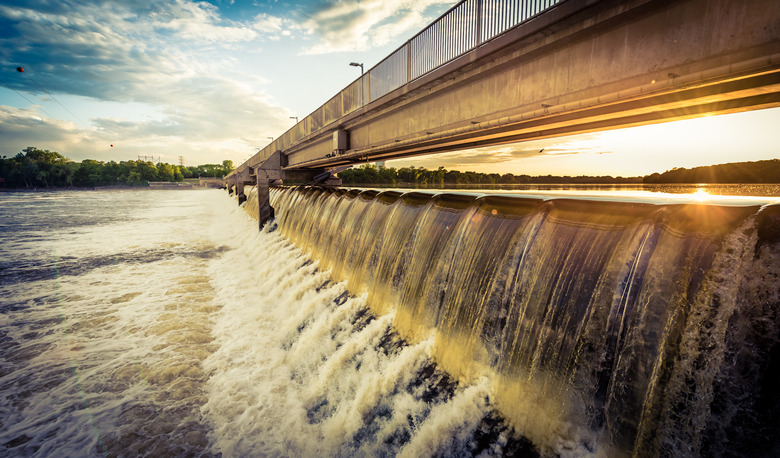How To Build A Dam For A School Project
When you dam up a river, you have to think about more than just holding back the river. Water continues to flow, and if it doesn't find a way around the dam, it eventually flows over it. Beavers are content to just allow the water to flow around the dam, but engineers who build hydroelectric dams take advantage of the continuing flow of the river by using it to spin a turbine. To do this, they design a spillway into the dam to direct the water flow in a controlled way. It's easy to demonstrate how this works when you build a small dam for a school project.
It Takes a River
It Takes a River
If you're going to construct a dam, you need a river, and it's easy to make a small one with a plastic paint tray, some rocks, sand and gravel, a bucket of water and a small submersible pump, such as you would use for an indoor fountain.
Fill the bottom of the paint tray with sand, then add rocks and gravel to simulate a rocky hillside. Construct a channel in the middle of the terrain for the river, making the banks as high as you can. Remember that dams are usually constructed in ravines or canyons, not on flat land.
Set the paint tray near the edge of a table so it slants toward the edge, and put a bucket underneath the table just under the edge of the tray to catch water. Put a submersible pump in the bucket and run a tube from the pump to the other end of the tray, which is the start of the river. Fill the bucket with enough water to cover the pump, turn on the pump, and the river starts to flow.
Construct the Dam
Construct the Dam
The dam can be anywhere along the path of the river, but to demonstrate the effect of the spillway, it's best if it's near the edge of the table. Cut off the bottom of a 1-quart or 1-pint cardboard milk carton. Make the cuts about 2 inches from the bottom so you have a box shape with 2-inch sides. Clear a space for it in the riverbed and place it on its side with the bottom facing the edge of the table. Fill in the gaps around the milk container with sand and gravel to prevent water from passing. You may have to pack the gravel and sand tightly to stop the water. It may help to add clay to the mixture to make it more waterproof.
Make Two Spillways
Make Two Spillways
After the dam is complete, turn on the pump and watch what happens. If the dam is solid, water backs up behind it, forming a lake, and the level rises until the water finds a way to get by. Turn off the pump when this happens.
Using a screw or nail, punch two small holes in the center of the milk carton along a vertical line. Make one hole about a half inch from the bottom and another about a half inch from the top. Cover each hole separately with duct tape.
Turn the pump back on, let the water back up behind the dam, and uncover the lowest hole. Note whether or not the water level in the lake drops. If the water level keeps rising, make the hole a little bigger to equalize the output to the amount of water flowing in the river. Once the water level remains stationary, stop the pump, uncover the other the hole and make it the same size. Cover them back up again.
Appreciate Your Creation
Appreciate Your Creation
You've now created a tiny mockup of one of the world's large hydroelectric power sources, such as the Hoover Dam. Turn the pump back on, let water back up to form a lake, and uncover the lowest hole or spillway. Note how water squirts out under pressure. If it were a real dam, the pressurized water would spin a turbine to generate electricity. Now open the second spillway and watch the water level in the lake drop. This spillway prevents the dam from overflowing when the flow in the river is higher than usual, such as during a heavy rainstorm. Real dams often have a second emergency spillway to prevent overflow in flood conditions.
Cite This Article
MLA
Deziel, Chris. "How To Build A Dam For A School Project" sciencing.com, https://www.sciencing.com/build-dam-school-project-6234206/. 13 March 2018.
APA
Deziel, Chris. (2018, March 13). How To Build A Dam For A School Project. sciencing.com. Retrieved from https://www.sciencing.com/build-dam-school-project-6234206/
Chicago
Deziel, Chris. How To Build A Dam For A School Project last modified March 24, 2022. https://www.sciencing.com/build-dam-school-project-6234206/
